Improved Semi-Supervised Data-Mining-Based Schemes for Fault Detection in a Grid-Connected Photovoltaic System
Abstract
1. Introduction
2. PV Installation Description
3. Materials and Methods
3.1. PLS (Partial Least Square)
3.2. PCR (Principal Component Regression)
3.3. TEWMA (Triple Exponential Weighted Moving Average)
3.4. KDE-TEWMA (Kernel Density Estimation TEWMA)
3.5. Dataset Analysis
4. The LVR-TEWMA-Based Fault Detection in PV Systems
5. Results
5.1. Scenarios with String Faults
5.2. Scenarios with Inverter Disconnections
5.3. Scenario with Circuit Breaker Faults
5.4. Short-Circuit Fault
5.5. Sensor Bias Faults in the Pyranometer
6. Conclusions
Author Contributions
Funding
Institutional Review Board Statement
Informed Consent Statement
Data Availability Statement
Conflicts of Interest
References
- Ahmed, W.; Sheikh, J.A.; Farjana, S.H.; Mahmud, M.A.P. Defects Impact on PV System GHG Mitigation Potential and Climate Change. Sustainability 2021, 13, 7793. [Google Scholar] [CrossRef]
- IEA PVPS. Trends in Photovoltaic Applications. 2021. Available online: https://tecsol.blogs.com/files/iea-pvps-trends-report-2021-1.pdf (accessed on 23 October 2022).
- Garoudja, E.; Harrou, F.; Sun, Y.; Kara, K.; Chouder, A.; Silvestre, S. Statistical fault detection in photovoltaic systems. Sol. Energy 2017, 150, 485–499. [Google Scholar] [CrossRef]
- Alam, M.K.; Khan, F.; Johnson, J.; Flicker, J. A comprehensive review of catastrophic faults in PV arrays: Types, detection, and mitigation techniques. IEEE J. Photovolt. 2015, 5, 982–997. [Google Scholar] [CrossRef]
- Hare, J.; Shi, X.; Gupta, S.; Bazzi, A. Fault diagnostics in smart micro-grids: A survey. Renew. Sustain. Energy Rev. 2016, 60, 1114–1124. [Google Scholar] [CrossRef]
- Ye, J.; Giani, A.; Elasser, A.; Mazumder, S.K.; Farnell, C.; Mantooth, H.A.; Kim, T.; Liu, J.; Chen, B.; Seo, G.S.; et al. A Review of Cyber–Physical Security for Photovoltaic Systems. IEEE J. Emerg. Sel. Top. Power Electron. 2021, 10, 4879–4901. [Google Scholar] [CrossRef]
- Wang, W.; Harrou, F.; Bouyeddou, B.; Senouci, S.M.; Sun, Y. A stacked deep learning approach to cyber-attacks detection in industrial systems: Application to power system and gas pipeline systems. Clust. Comput. 2022, 25, 561–578. [Google Scholar] [CrossRef]
- Wang, W.; Harrou, F.; Bouyeddou, B.; Senouci, S.M.; Sun, Y. Cyber-attacks detection in industrial systems using artificial intelligence-driven methods. Int. J. Crit. Infrastruct. Prot. 2022, 38, 100542. [Google Scholar] [CrossRef]
- Le, M.; Nguyen, D.K.; Dao, V.D.; Vu, N.H.; Vu, H.H.T. Remote anomaly detection and classification of solar photovoltaic modules based on deep neural network. Sustain. Energy Technol. Assess. 2021, 48, 101545. [Google Scholar] [CrossRef]
- Janarthanan, R.; Maheshwari, R.U.; Shukla, P.K.; Shukla, P.K.; Mirjalili, S.; Kumar, M. Intelligent detection of the PV faults based on artificial neural network and type 2 fuzzy systems. Energies 2021, 14, 6584. [Google Scholar] [CrossRef]
- Harrou, F.; Saidi, A.; Sun, Y.; Khadraoui, S. Monitoring of photovoltaic systems using improved kernel-based learning schemes. IEEE J. Photovolt. 2021, 11, 806–818. [Google Scholar] [CrossRef]
- Mellit, A.; Tina, G.M.; Kalogirou, S.A. Fault detection and diagnosis methods for photovoltaic systems: A review. Renew. Sustain. Energy Rev. 2018, 91, 1–17. [Google Scholar] [CrossRef]
- Madeti, S.R.; Singh, S.N. Modeling of PV system based on experimental data for fault detection using kNN method. Sol. Energy 2018, 173, 139–151. [Google Scholar] [CrossRef]
- Badr, M.M.; Hamad, M.S.; Abdel-Khalik, A.S.; Hamdy, R.A.; Ahmed, S.; Hamdan, E. Fault Identification of Photovoltaic Array Based on Machine Learning Classifiers. IEEE Access 2021, 9, 159113–159132. [Google Scholar] [CrossRef]
- Benkercha, R.; Moulahoum, S. Fault detection and diagnosis based on C4. 5 decision tree algorithm for grid connected PV system. Sol. Energy 2018, 173, 610–634. [Google Scholar] [CrossRef]
- Harrou, F.; Taghezouit, B.; Sun, Y. Robust and flexible strategy for fault detection in grid-connected photovoltaic systems. Energy Convers. Manag. 2019, 180, 1153–1166. [Google Scholar] [CrossRef]
- Harrou, F.; Dairi, A.; Taghezouit, B.; Sun, Y. An unsupervised monitoring procedure for detecting anomalies in photovoltaic systems using a one-class Support Vector Machine. Sol. Energy 2019, 179, 48–58. [Google Scholar] [CrossRef]
- Harrou, F.; Sun, Y.; Taghezouit, B.; Saidi, A.; Hamlati, M.E. Reliable fault detection and diagnosis of photovoltaic systems based on statistical monitoring approaches. Renew. Energy 2018, 116, 22–37. [Google Scholar] [CrossRef]
- Huang, C.M.; Chen, S.J.; Yang, S.P. A Parameter Estimation Method for a Photovoltaic Power Generation System Based on a Two-Diode Model. Energies 2022, 15, 1460. [Google Scholar] [CrossRef]
- Kang, B.K.; Kim, S.T.; Bae, S.H.; Park, J.W. Diagnosis of output power lowering in a PV array by using the Kalman-filter algorithm. IEEE Trans. Energy Convers. 2012, 27, 885–894. [Google Scholar] [CrossRef]
- Skomedal, Å.F.; Øgaard, M.B.; Haug, H.; Marstein, E.S. Robust and fast detection of small power losses in large-scale PV systems. IEEE J. Photovolt. 2021, 11, 819–826. [Google Scholar] [CrossRef]
- Spataru, S.; Sera, D.; Kerekes, T.; Teodorescu, R. Diagnostic method for photovoltaic systems based on light I–V measurements. Sol. Energy 2015, 119, 29–44. [Google Scholar] [CrossRef]
- Chouder, A.; Silvestre, S. Automatic supervision and fault detection of PV systems based on power losses analysis. Energy Convers. Manag. 2010, 51, 1929–1937. [Google Scholar] [CrossRef]
- Hou, Z.S.; Wang, Z. From model-based control to data-driven control: Survey, classification and perspective. Inf. Sci. 2013, 235, 3–35. [Google Scholar] [CrossRef]
- Taghezouit, B.; Harrou, F.; Sun, Y.; Arab, A.H.; Larbes, C. Multivariate statistical monitoring of photovoltaic plant operation. Energy Convers. Manag. 2020, 205, 112317. [Google Scholar] [CrossRef]
- Fadhel, S.; Delpha, C.; Diallo, D.; Bahri, I.; Migan, A.; Trabelsi, M.; Mimouni, M.F. PV shading fault detection and classification based on IV curve using principal component analysis: Application to isolated PV system. Sol. Energy 2019, 179, 1–10. [Google Scholar] [CrossRef]
- Amaral, T.G.; Pires, V.F.; Pires, A.J. Fault detection in PV tracking systems using an image processing algorithm based on PCA. Energies 2021, 14, 7278. [Google Scholar] [CrossRef]
- Deceglie, M.G.; Micheli, L.; Muller, M. Quantifying soiling loss directly from PV yield. IEEE J. Photovolt. 2018, 8, 547–551. [Google Scholar] [CrossRef]
- Kiliç, H.; Gumus, B.; Khaki, B.; Yilmaz, M.; Palensky, P.; Authority, P. A Robust Data-Driven Approach for Fault Detection in Photovoltaic Arrays. In Proceedings of the 10th IEEE PES Innovative Smart Grid Technologies Europe, ISGT-Europe 2020, Virtual, 26–28 October 2020. [Google Scholar]
- Xiong, Q.; Liu, X.; Feng, X.; Gattozzi, A.L.; Shi, Y.; Zhu, L.; Ji, S.; Hebner, R.E. Arc fault detection and localization in photovoltaic systems using feature distribution maps of parallel capacitor currents. IEEE J. Photovolt. 2018, 8, 1090–1097. [Google Scholar] [CrossRef]
- Kumar, B.P.; Ilango, G.S.; Reddy, M.J.B.; Chilakapati, N. Online fault detection and diagnosis in photovoltaic systems using wavelet packets. IEEE J. Photovolt. 2017, 8, 257–265. [Google Scholar] [CrossRef]
- Edun, A.S.; Kingston, S.; LaFlamme, C.; Benoit, E.; Scarpulla, M.A.; Furse, C.M.; Harley, J.B. Detection and localization of disconnections in a large-scale string of photovoltaics using SSTDR. IEEE J. Photovolt. 2021, 11, 1097–1104. [Google Scholar] [CrossRef]
- Wang, M.H.; Lin, Z.H.; Lu, S.D. A Fault Detection Method Based on CNN and Symmetrized Dot Pattern for PV Modules. Energies 2022, 15, 6449. [Google Scholar] [CrossRef]
- Cui, F.; Tu, Y.; Gao, W. A Photovoltaic System Fault Identification Method Based on Improved Deep Residual Shrinkage Networks. Energies 2022, 15, 3961. [Google Scholar] [CrossRef]
- Harrou, F.; Taghezouit, B.; Sun, Y. Improved kNN-based monitoring schemes for detecting faults in PV systems. IEEE J. Photovolt. 2019, 9, 811–821. [Google Scholar] [CrossRef]
- Harrou, F.; Taghezouit, B.; Khadraoui, S.; Dairi, A.; Sun, Y.; Hadj Arab, A. Ensemble Learning Techniques-Based Monitoring Charts for Fault Detection in Photovoltaic Systems. Energies 2022, 15, 6716. [Google Scholar] [CrossRef]
- Karatepe, E.; Hiyama, T. Controlling of artificial neural network for fault diagnosis of photovoltaic array. In Proceedings of the 2011 16th International Conference on Intelligent System Applications to Power Systems, Hersonissos, Greece, 25–28 September 2011; pp. 1–6. [Google Scholar]
- Chen, S.Q.; Yang, G.J.; Gao, W.; Guo, M.F. Photovoltaic fault diagnosis via semisupervised ladder network with string voltage and current measures. IEEE J. Photovolt. 2020, 11, 219–231. [Google Scholar] [CrossRef]
- Gaggero, G.B.; Rossi, M.; Girdinio, P.; Marchese, M. Detecting System Fault/Cyberattack within a Photovoltaic System Connected to the Grid: A Neural Network-Based Solution. J. Sens. Actuator Netw. 2020, 9, 20. [Google Scholar] [CrossRef]
- Parvez, I.; Aghili, M.; Sarwat, A.I.; Rahman, S.; Alam, F. Online power quality disturbance detection by support vector machine in smart meter. J. Mod. Power Syst. Clean Energy 2019, 7, 1328–1339. [Google Scholar] [CrossRef]
- Madakyaru, M.; Harrou, F.; Sun, Y. Monitoring distillation column systems using improved nonlinear partial least squares-based strategies. IEEE Sens. J. 2019, 19, 11697–11705. [Google Scholar] [CrossRef]
- Kourti, T.; MacGregor, J.F. Process analysis, monitoring and diagnosis, using multivariate projection methods. Chemom. Intell. Lab. Syst. 1995, 28, 3–21. [Google Scholar] [CrossRef]
- Geladi, P.; Kowalski, B.R. Partial least-squares regression: A tutorial. Anal. Chim. Acta 1986, 185, 1–17. [Google Scholar] [CrossRef]
- Harrou, F.; Sun, Y.; Madakyaru, M. Kullback-leibler distance-based enhanced detection of incipient anomalies. J. Loss Prev. Process Ind. 2016, 44, 73–87. [Google Scholar] [CrossRef]
- Harrou, F.; Sun, Y.; Hering, A.S.; Madakyaru, M.; Dairi, A. Linear Latent Variable Regression (LVR)-Based Process Monitoring; Elsevier BV: Amsterdam, The Netherlands, 2021. [Google Scholar]
- Li, B.; Morris, J.; Martin, E.B. Model selection for partial least squares regression. Chemom. Intell. Lab. Syst. 2002, 64, 79–89. [Google Scholar] [CrossRef]
- MacGregor, J.F.; Kourti, T. Statistical process control of multivariate processes. Control Eng. Pract. 1995, 3, 403–414. [Google Scholar] [CrossRef]
- Madakyaru, M.; Harrou, F.; Sun, Y. Improved data-based fault detection strategy and application to distillation columns. Process Saf. Environ. Prot. 2017, 107, 22–34. [Google Scholar] [CrossRef]
- Wang, X.; Kruger, U.; Lennox, B. Recursive partial least squares algorithms for monitoring complex industrial processes. Control. Eng. Pract. 2003, 11, 613–632. [Google Scholar] [CrossRef]
- Ahn, S.J.; Lee, C.J.; Jung, Y.; Han, C.; Yoon, E.S.; Lee, G. Fault diagnosis of the multi-stage flash desalination process based on signed digraph and dynamic partial least square. Desalination 2008, 228, 68–83. [Google Scholar] [CrossRef]
- Bouyeddou, B.; Harrou, F.; Saidi, A.; Sun, Y. An Effective Wind Power Prediction using Latent Regression Models. In Proceedings of the 2021 International Conference on ICT for Smart Society (ICISS), Bandung, Indonesia, 2–4 August 2021; pp. 1–6. [Google Scholar]
- Frank, L.E.; Friedman, J.H. A statistical view of some chemometrics regression tools. Technometrics 1993, 35, 109–135. [Google Scholar] [CrossRef]
- Harrou, F.; Nounou, M.N.; Nounou, H.N. Detecting abnormal ozone levels using PCA-based GLR hypothesis testing. In Proceedings of the 2013 IEEE Symposium on Computational Intelligence and Data Mining (CIDM), Singapore, 16–19 April 2013; pp. 95–102. [Google Scholar]
- Alevizakos, V.; Chatterjee, K.; Koukouvinos, C. The triple exponentially weighted moving average control chart. Qual. Technol. Quant. Manag. 2021, 18, 326–354. [Google Scholar] [CrossRef]
- Alevizakos, V.; Chatterjee, K.; Koukouvinos, C. A nonparametric triple exponentially weighted moving average sign control chart. Qual. Reliab. Eng. Int. 2021, 37, 1504–1523. [Google Scholar] [CrossRef]
- Mahmoud, M.A.; Woodall, W.H. An evaluation of the double exponentially weighted moving average control chart. Commun. Stat.—Simul. Comput. 2010, 39, 933–949. [Google Scholar] [CrossRef]
- Zhang, L.; Chen, G. An extended EWMA mean chart. Qual. Technol. Quant. Manag. 2005, 2, 39–52. [Google Scholar] [CrossRef]
- Zhang, L.; Bebbington, M.S.; Govindaraju, K.; Lai, C.D. Composite EWMA control charts. Commun. Stat.-Simul. Comput. 2004, 33, 1133–1158. [Google Scholar] [CrossRef]
- Martin, E.; Morris, A. Non-parametric confidence bounds for process performance monitoring charts. J. Proc. Control 1996, 6, 349–358. [Google Scholar] [CrossRef]
- Chen, Y.C. A tutorial on kernel density estimation and recent advances. Biostat. Epidemiol. 2017, 1, 161–187. [Google Scholar] [CrossRef]
- Mugdadi, A.R.; Ahmad, I.A. A bandwidth selection for kernel density estimation of functions of random variables. Comput. Stat. Data Anal. 2004, 47, 49–62. [Google Scholar] [CrossRef]
- Harrou, F.; Khaldi, B.; Sun, Y.; Cherif, F. An efficient statistical strategy to monitor a robot swarm. IEEE Sens. J. 2019, 20, 2214–2223. [Google Scholar] [CrossRef]
- Dairi, A.; Harrou, F.; Sun, Y.; Khadraoui, S. Short-term forecasting of photovoltaic solar power production using variational auto-encoder driven deep learning approach. Appl. Sci. 2020, 10, 8400. [Google Scholar] [CrossRef]
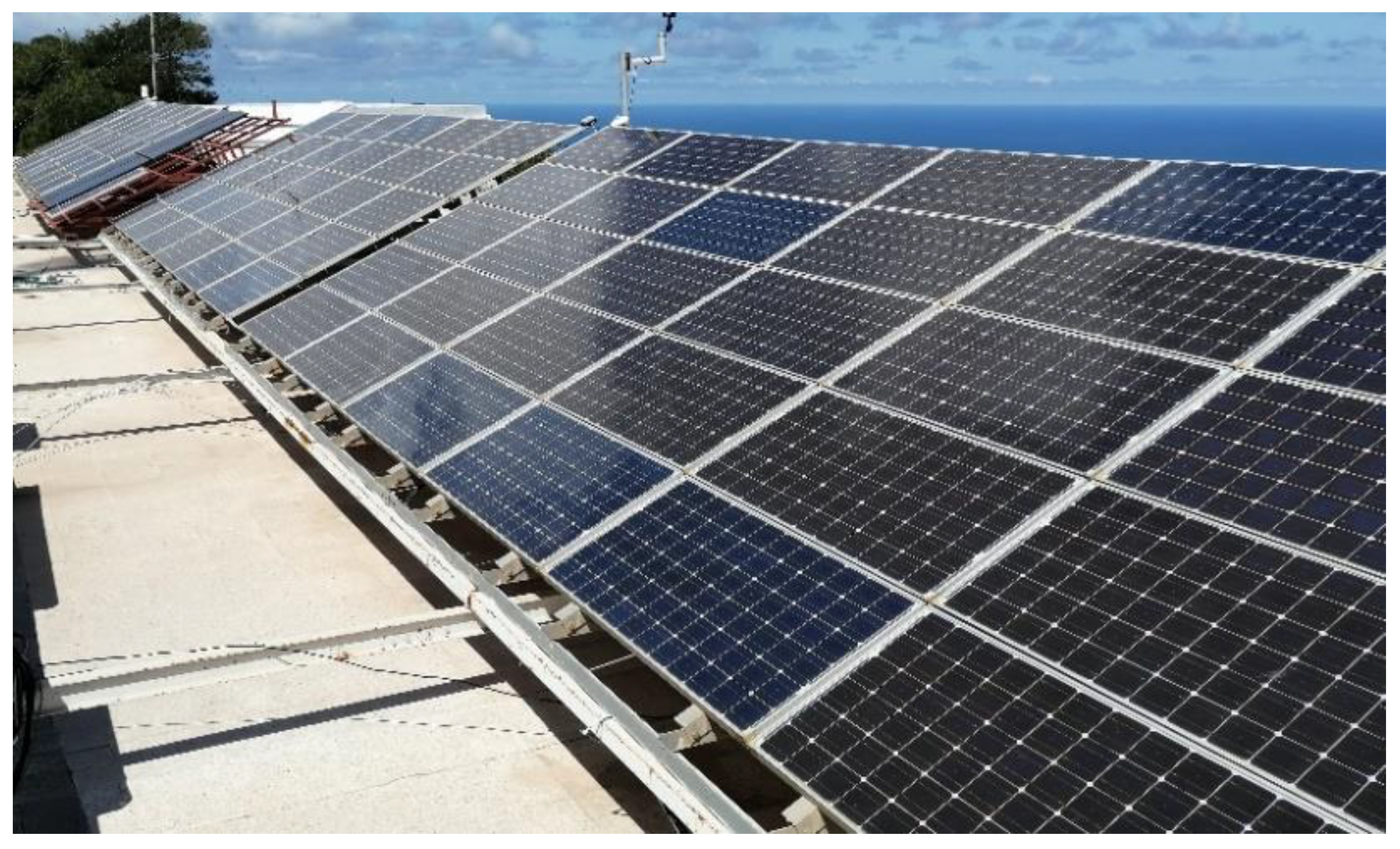
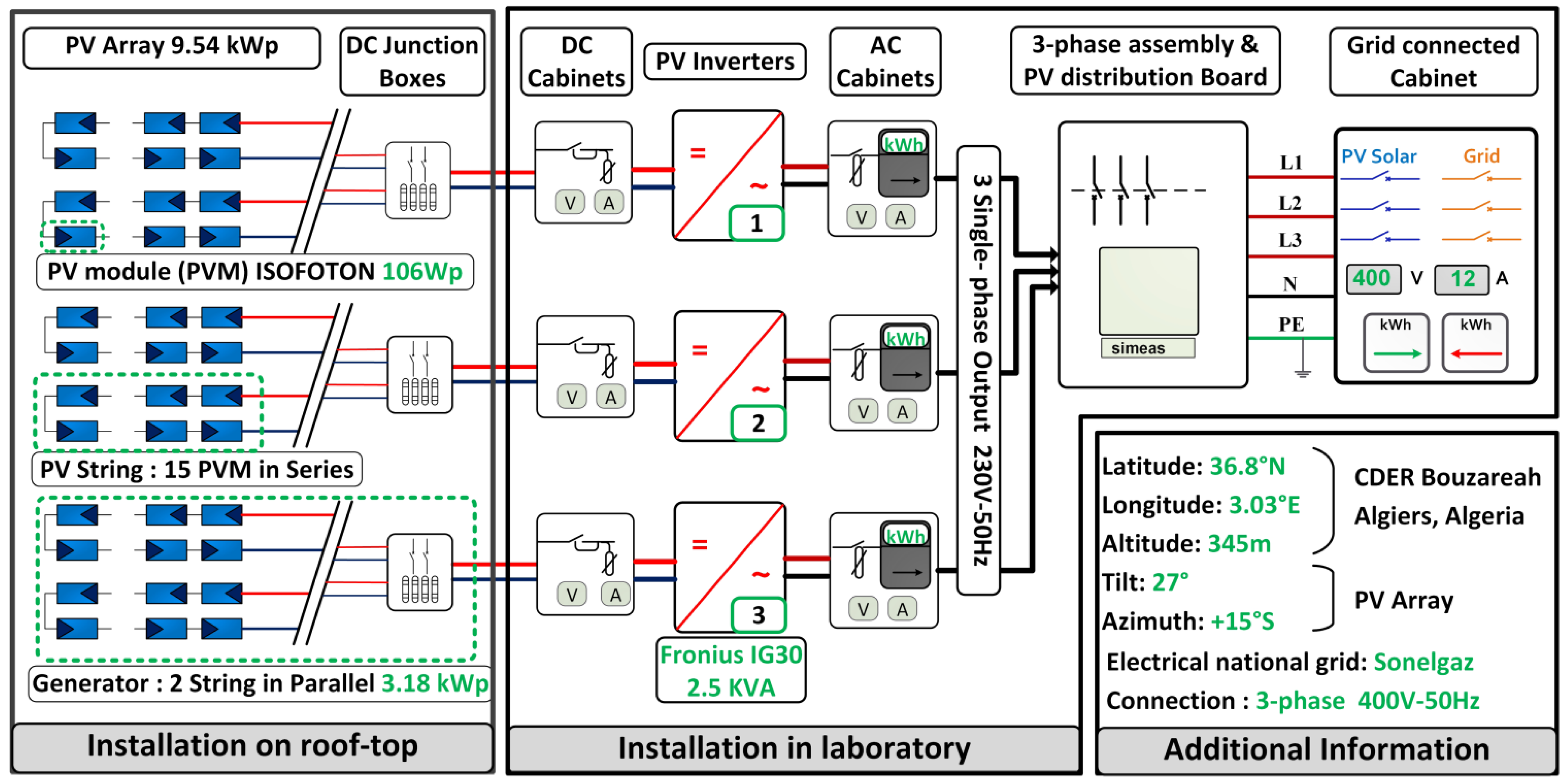
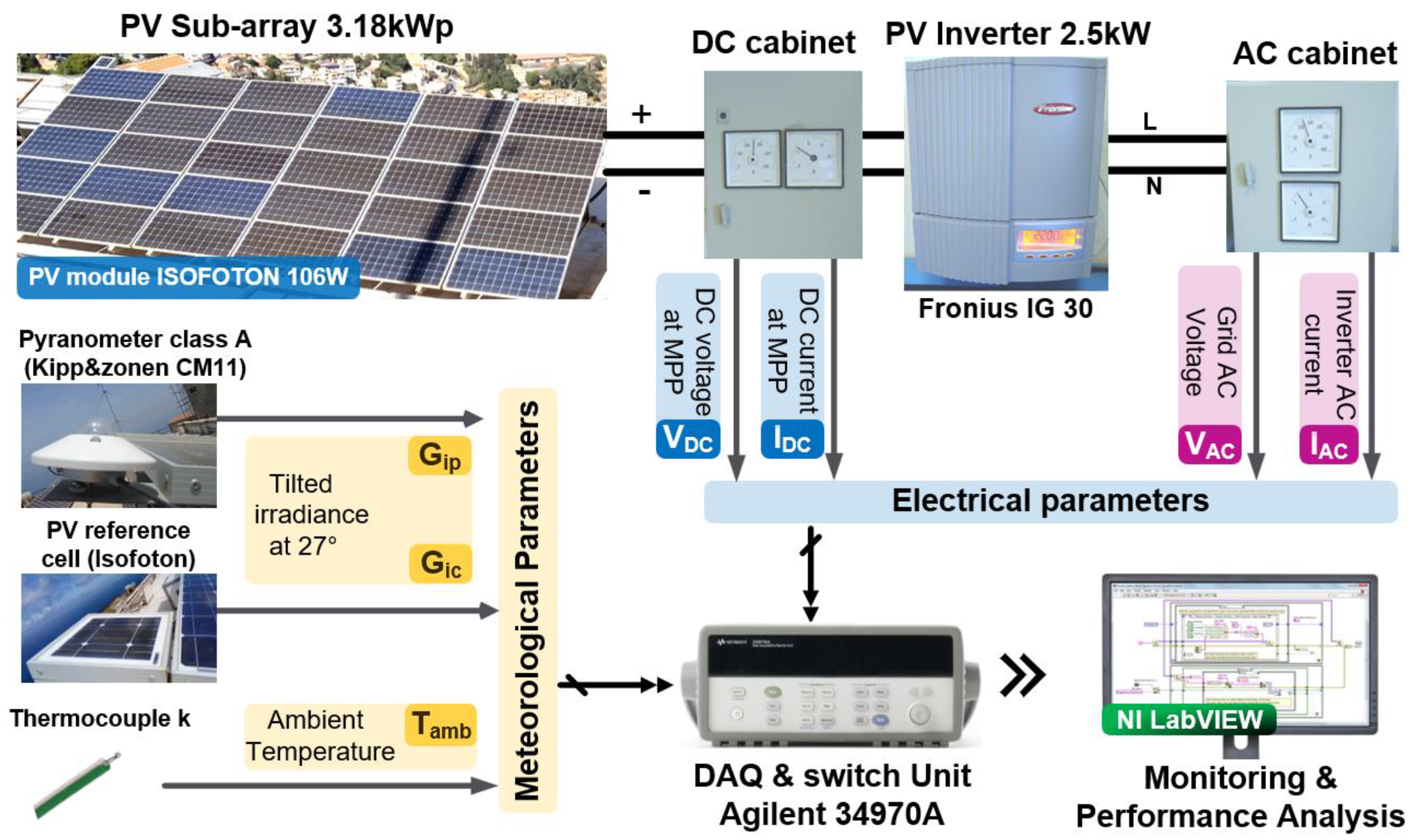
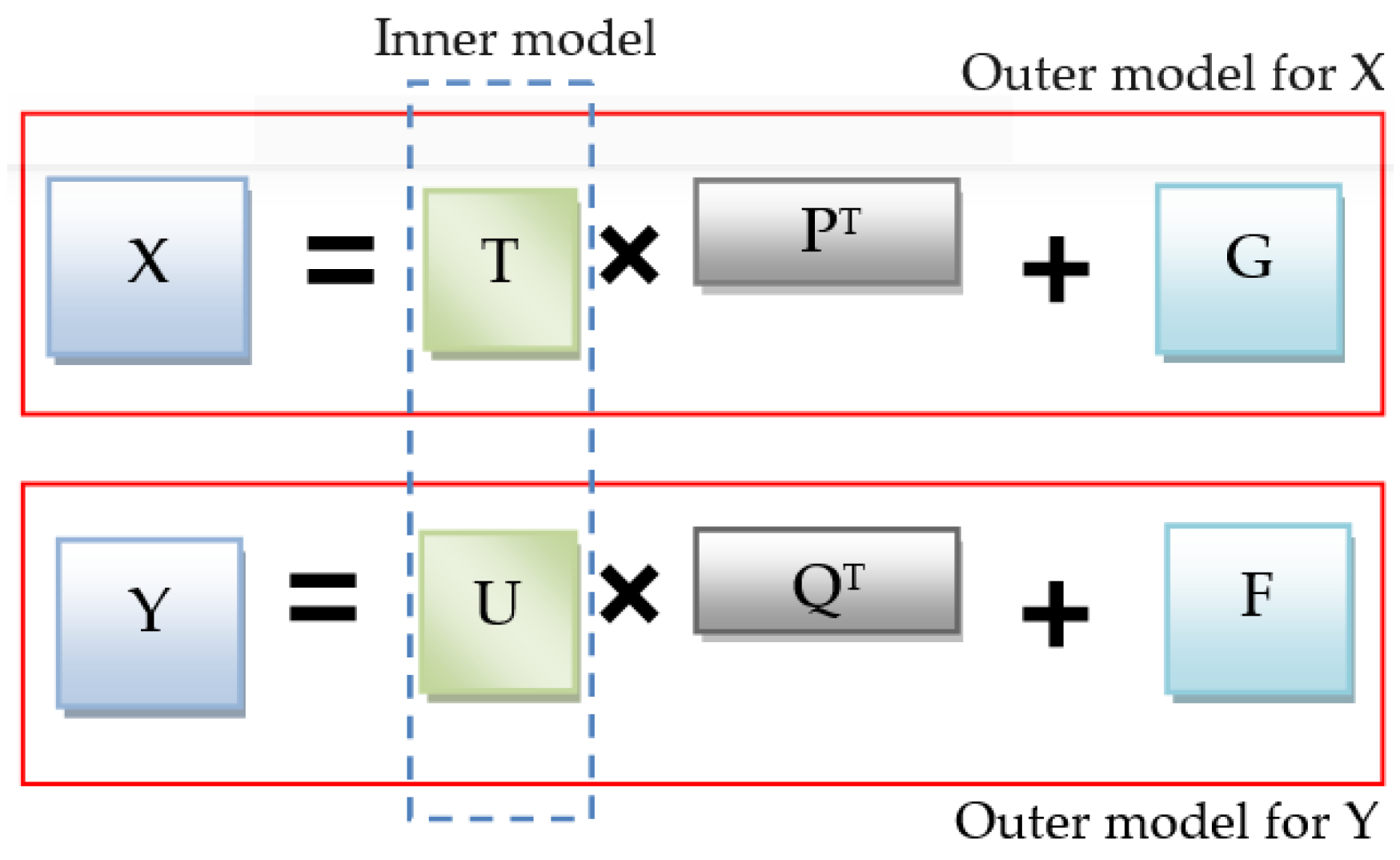

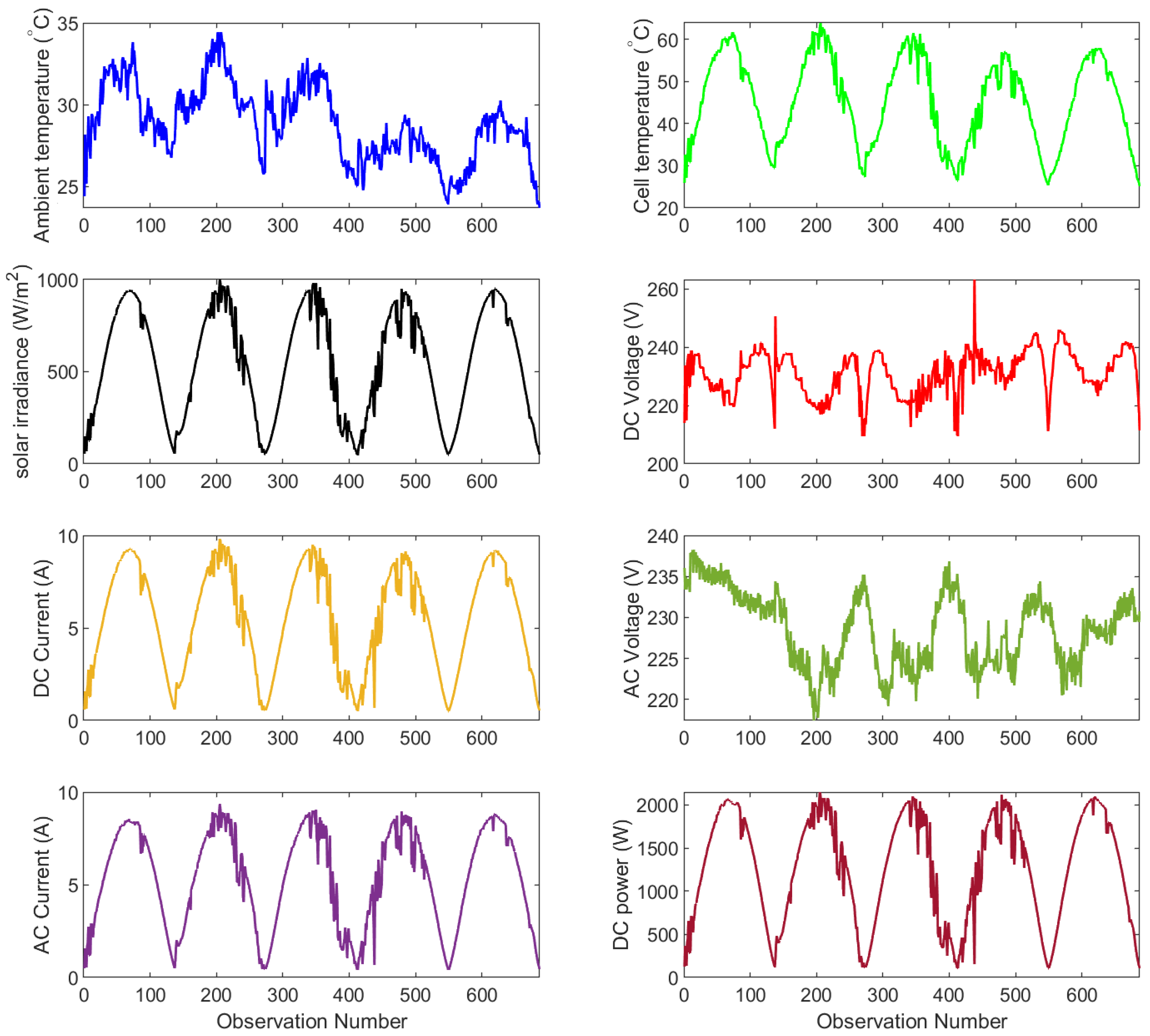
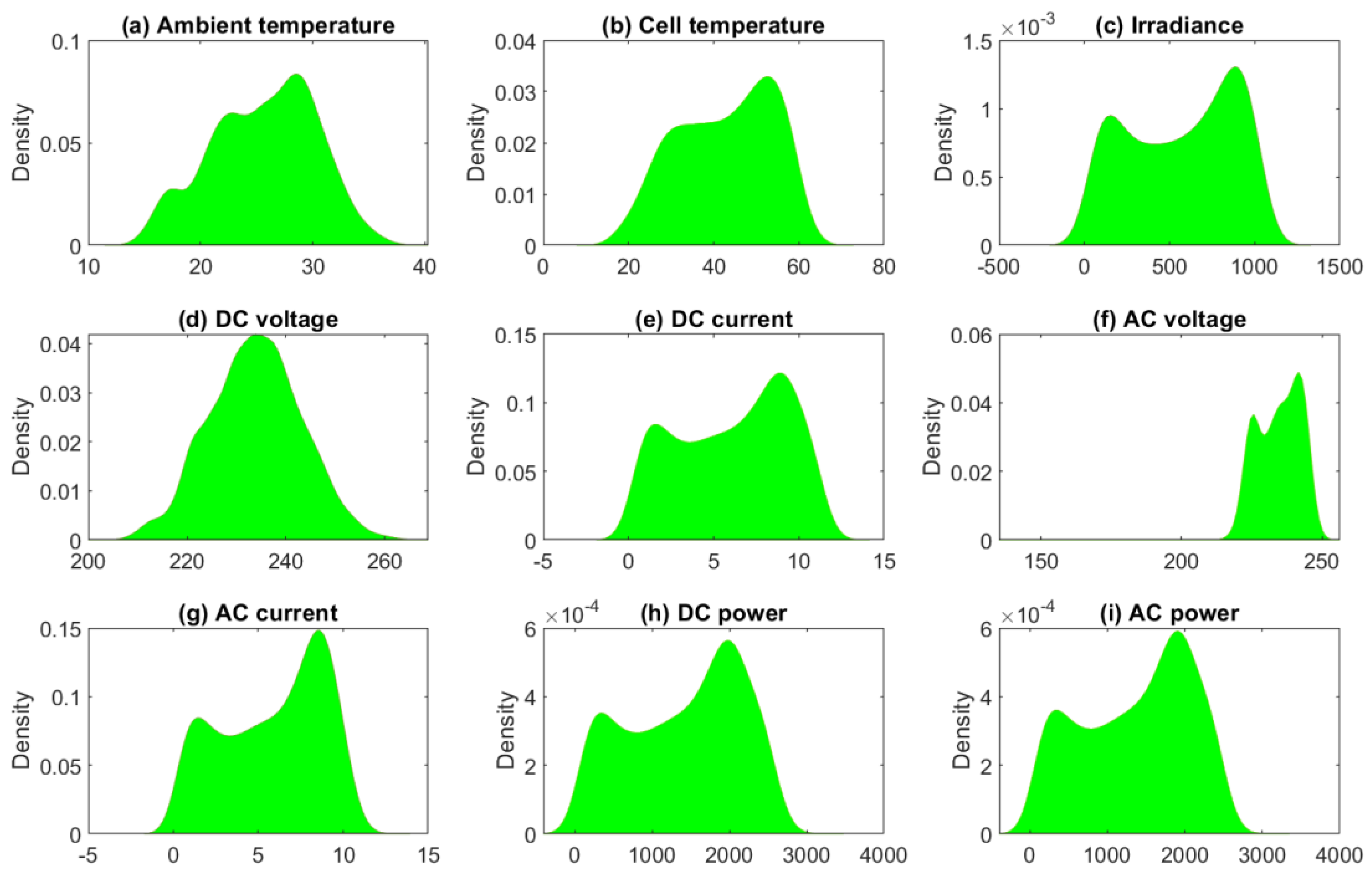
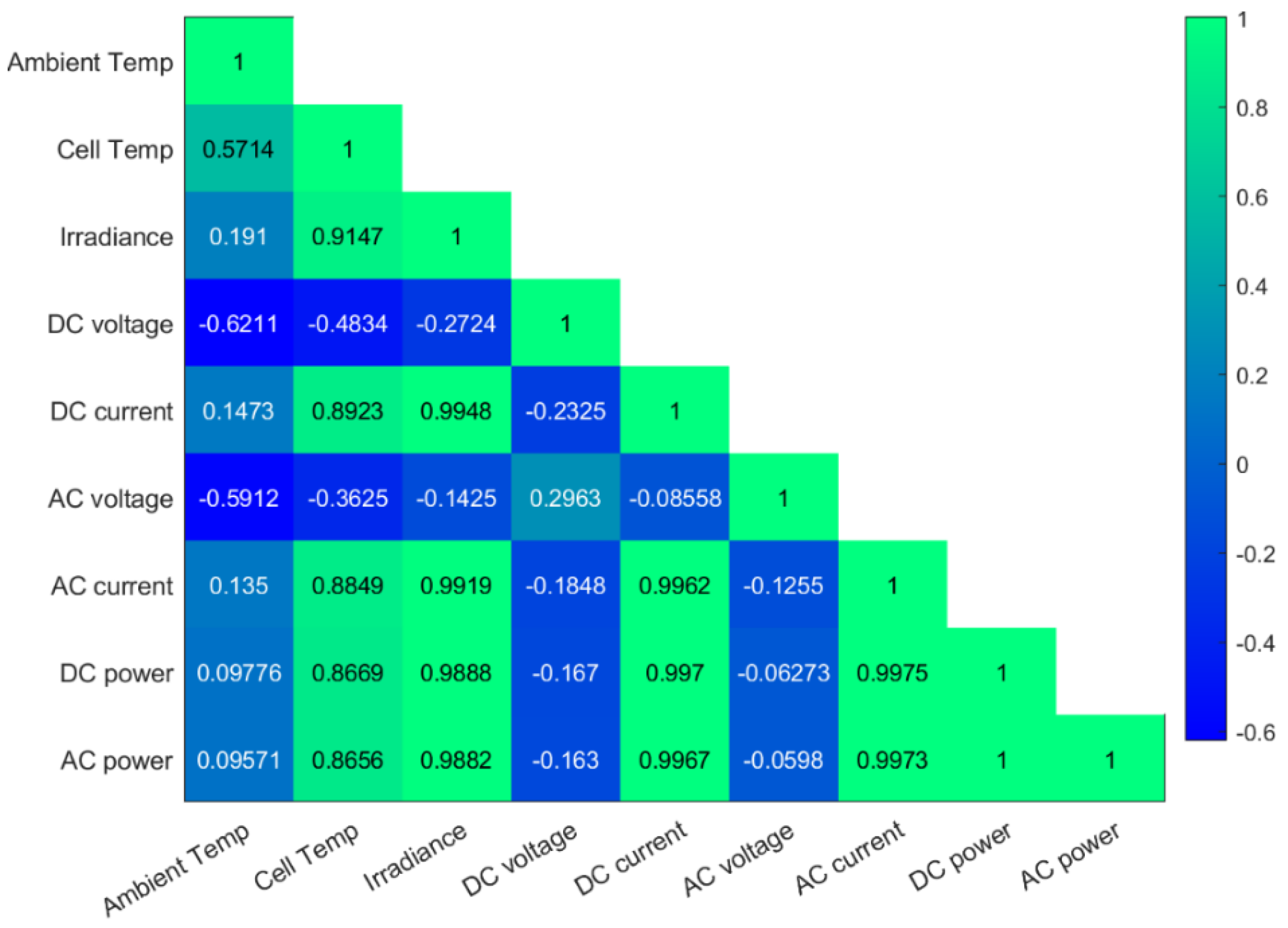
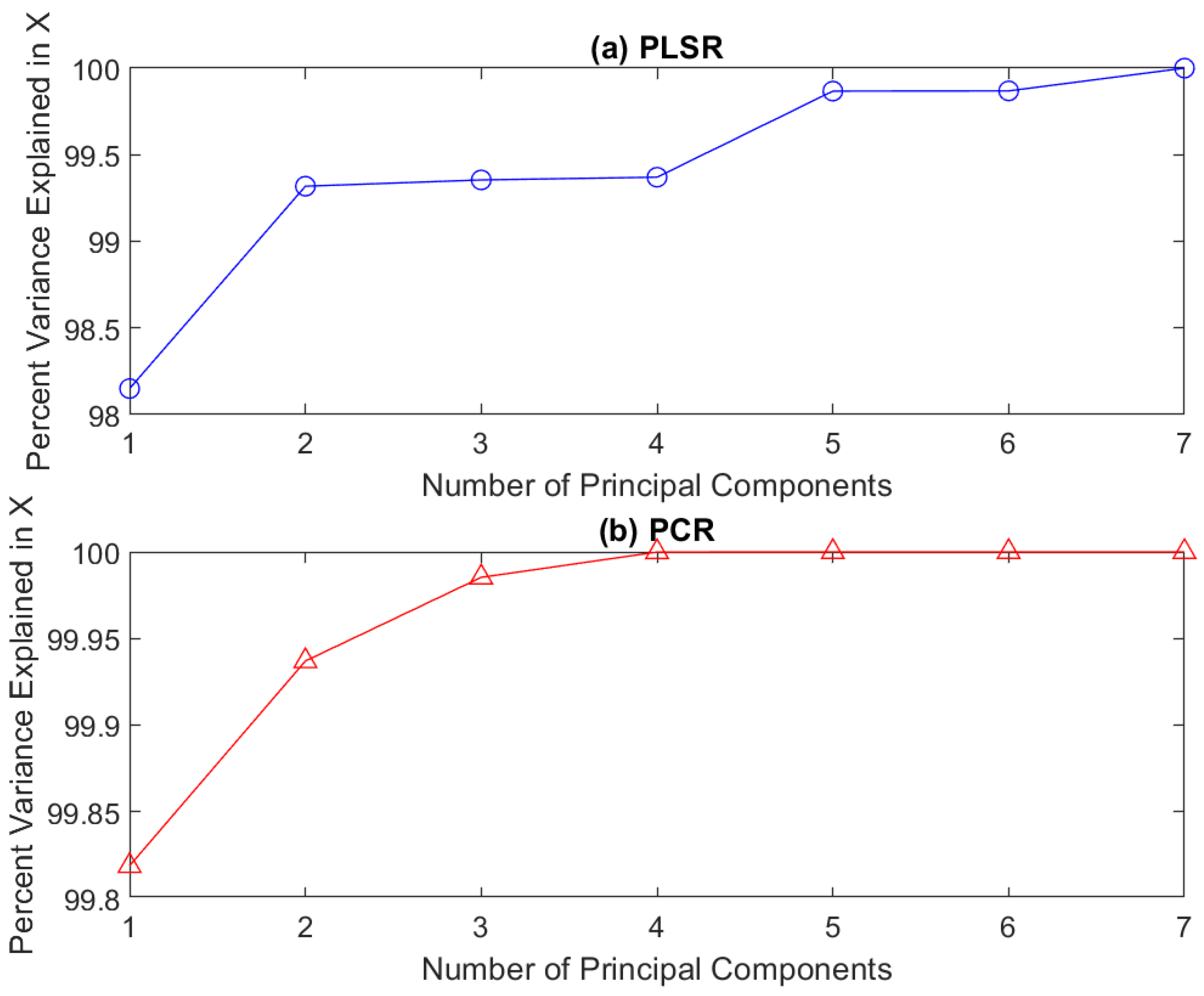
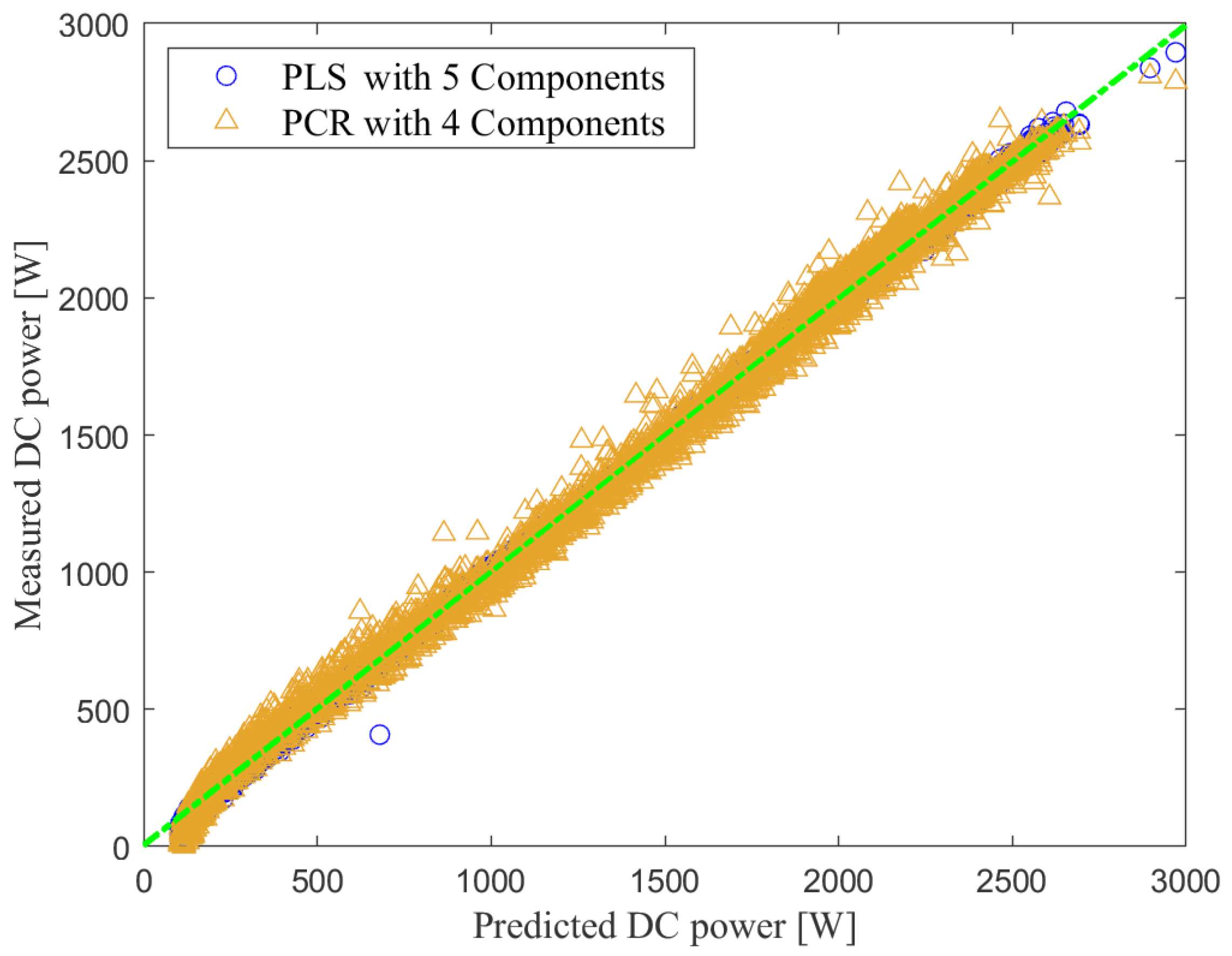
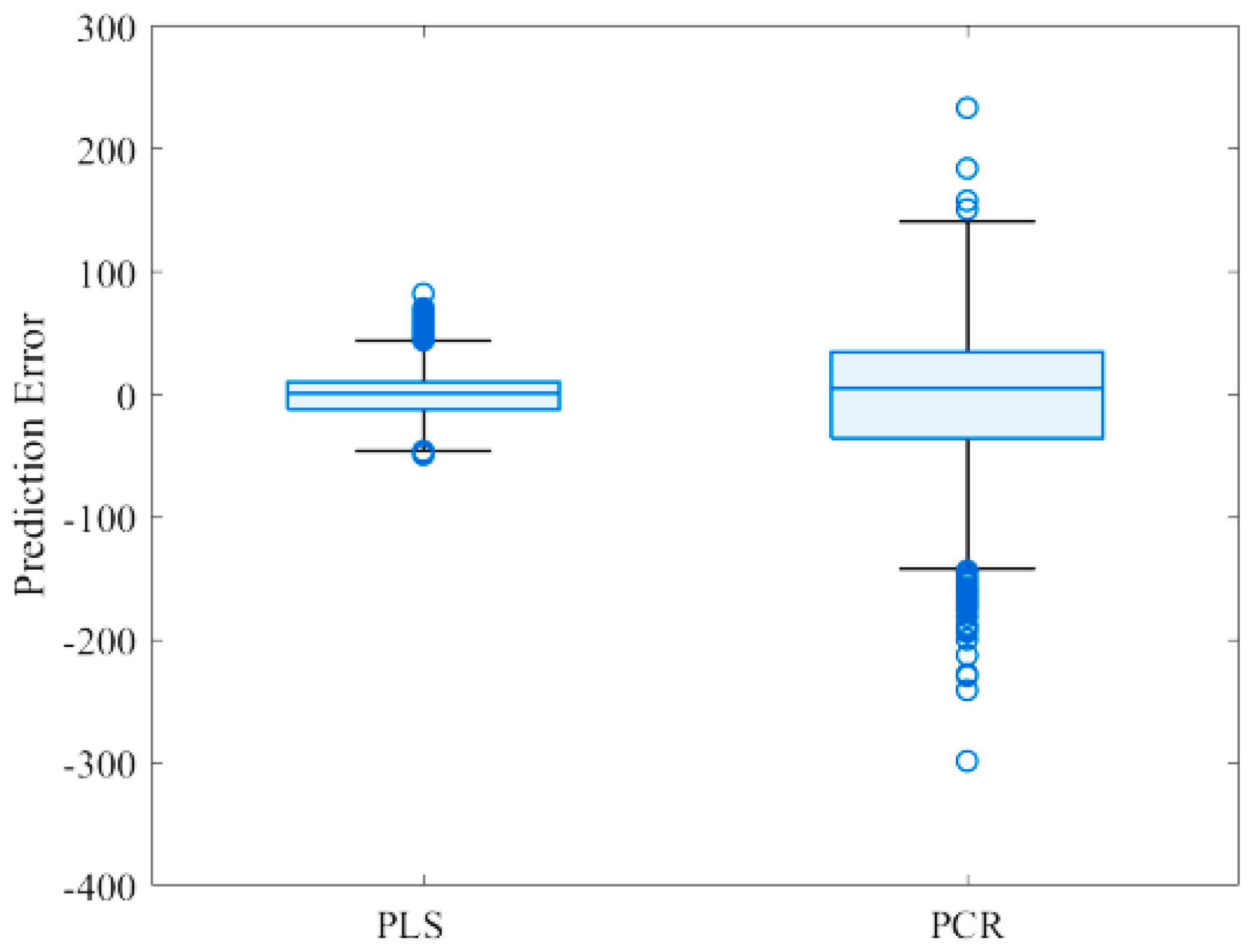

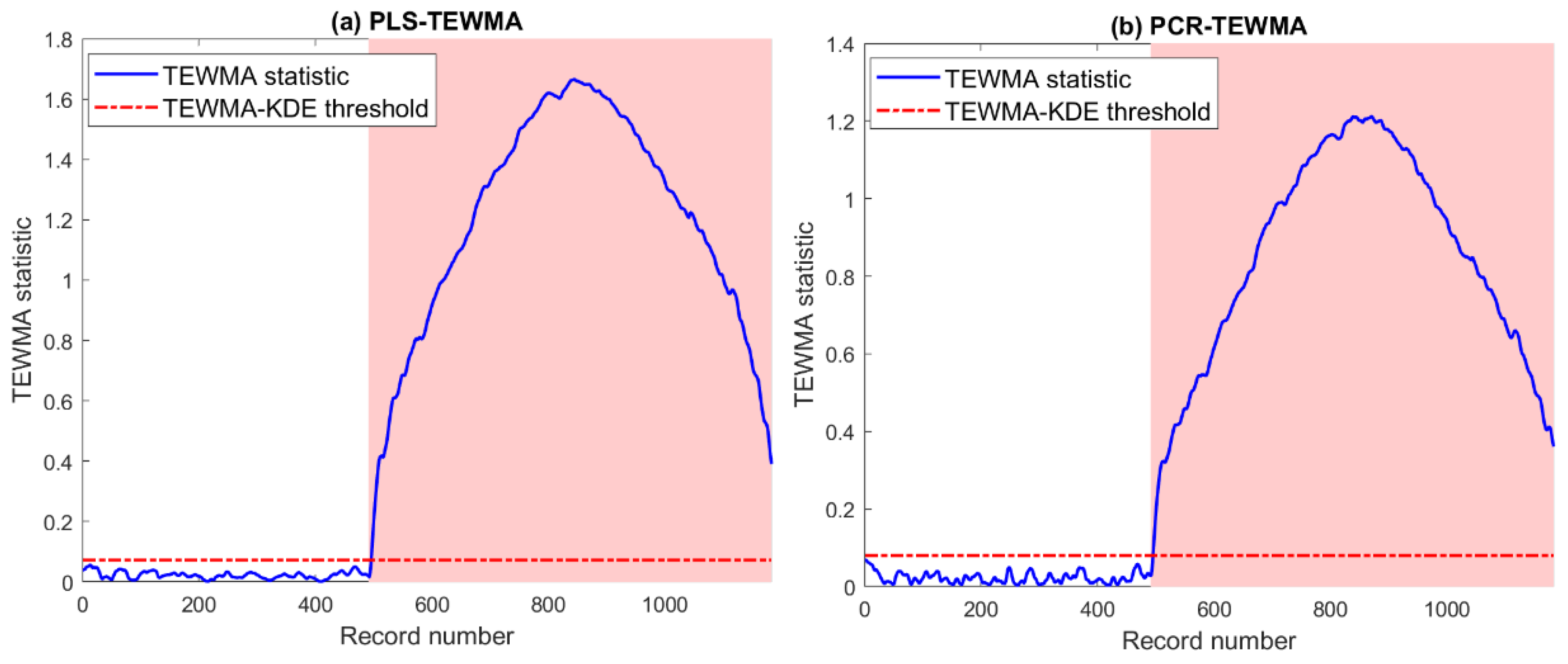
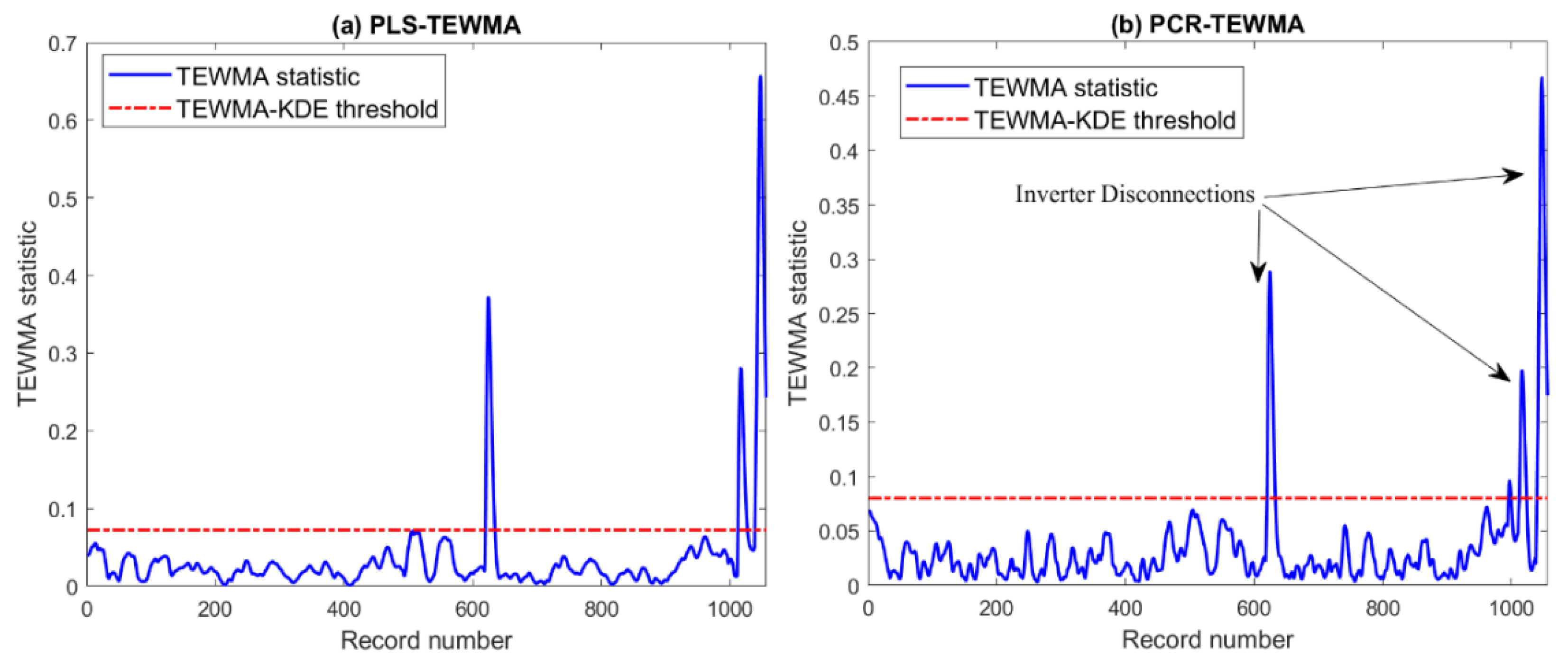
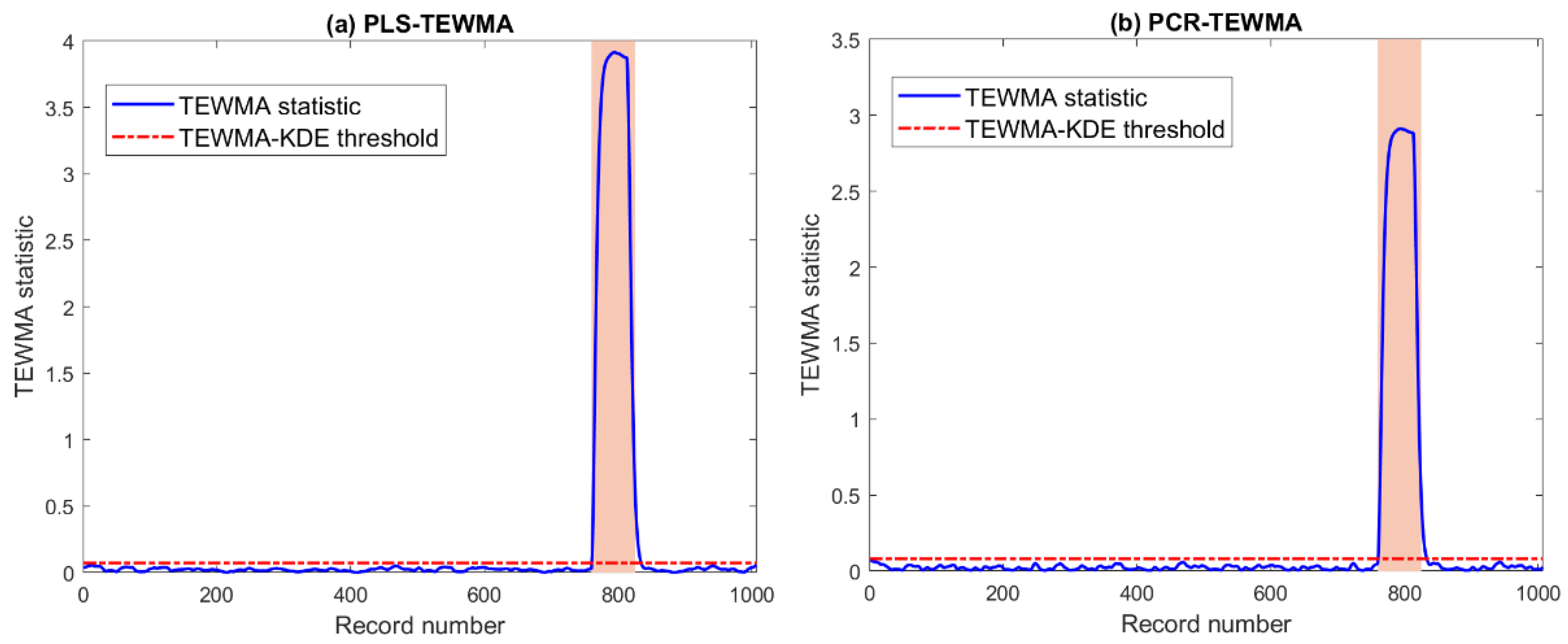
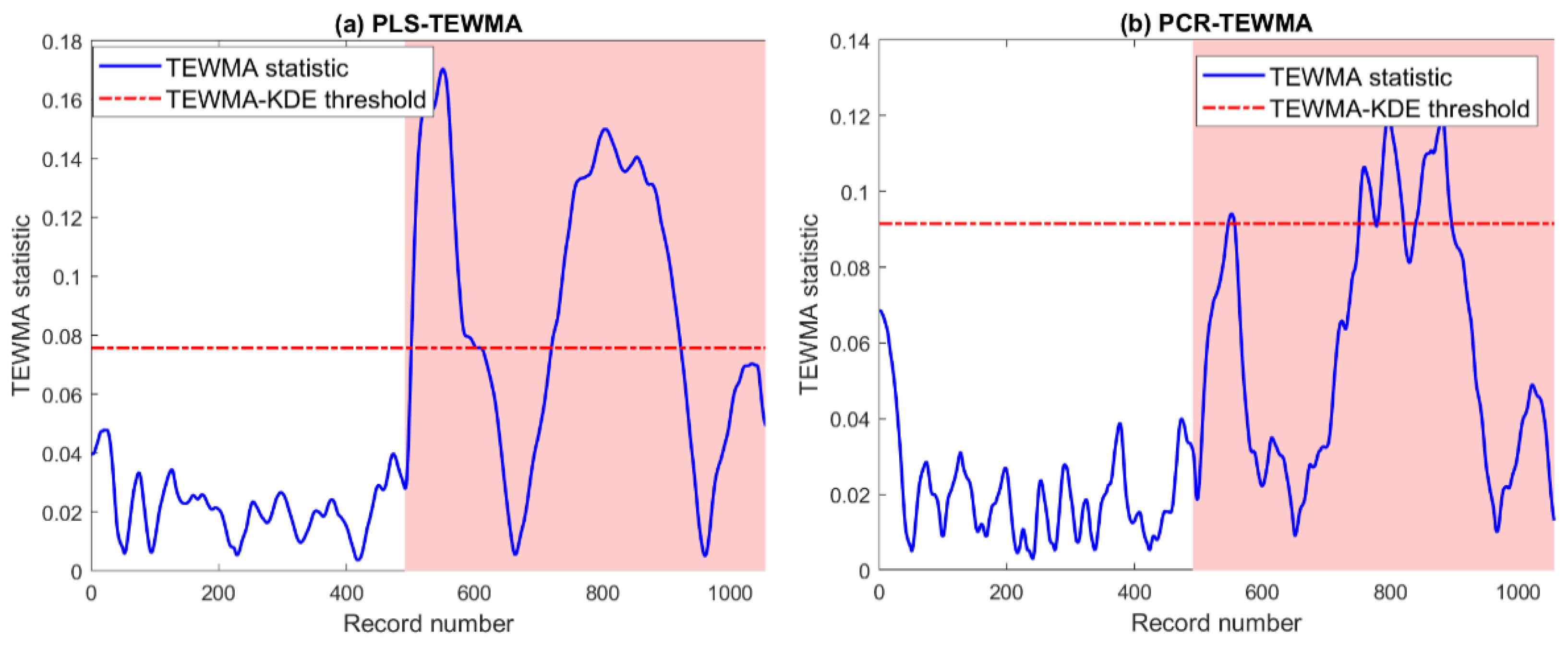

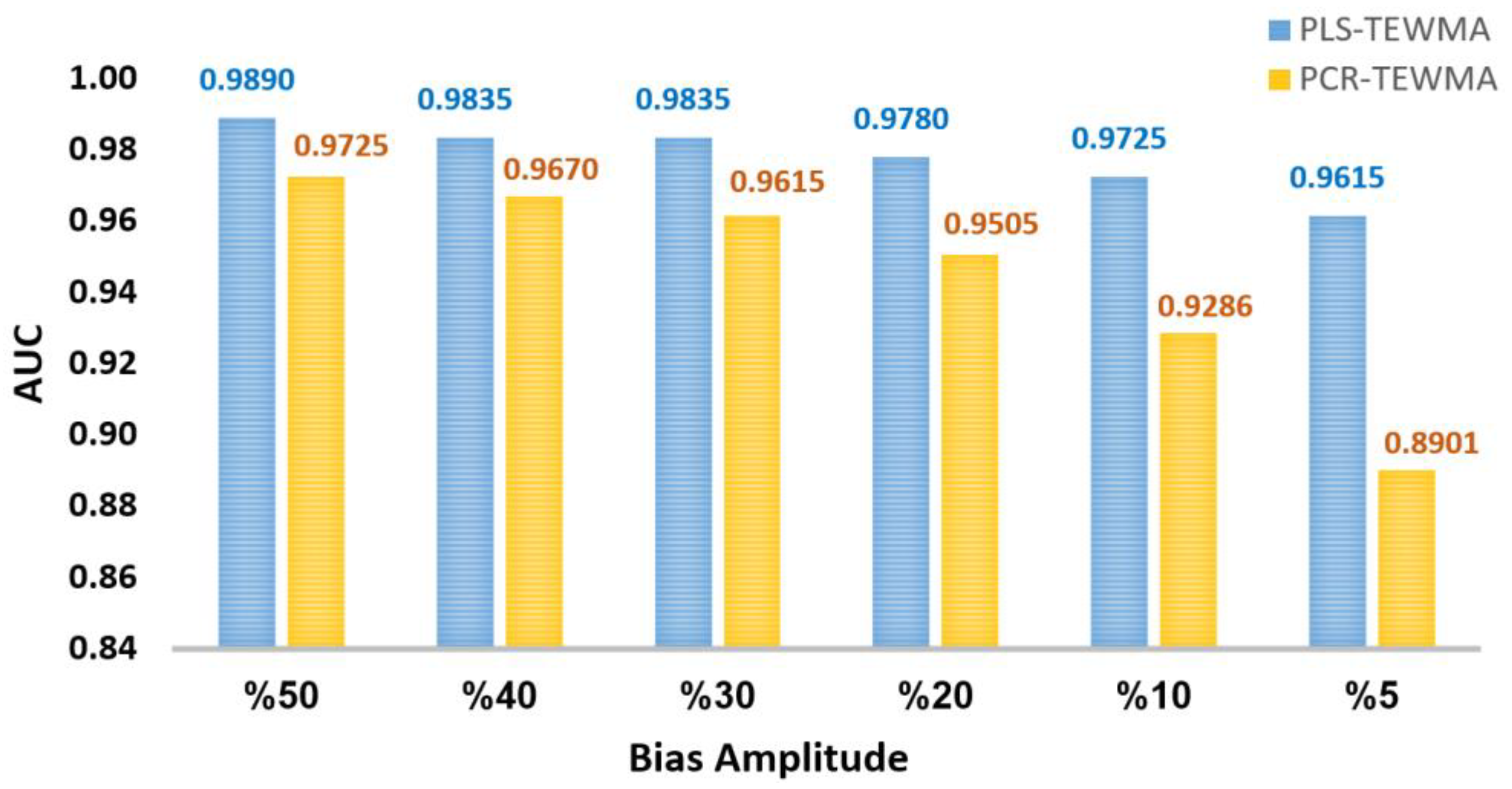
| Parameters | ISC (A) | VOC (V) | IMPP (A) | VMPP (V) | PM (W) |
|---|---|---|---|---|---|
| PV Module | 6.54 | 21.6 | 6.1 | 17.4 | 106 |
| PV Sub-Array | 13.08 | 324 | 12.2 | 261 | 3180 |
| Parameters | Nominal AC Power (W) | DC Voltage Range (V) | Inverter Efficiency (%) | AC Voltage Range (V) | Frequency Range (Hz) |
|---|---|---|---|---|---|
| Value | 2500 | 150–400 | 92.7–94.3 | 195–253 | 49.8–50.2 |
| Method | TPR | FPR | Accuracy | AUC | EER |
|---|---|---|---|---|---|
| PLS-TEWMA | 0.98 | 0 | 0.9942 | 0.99 | 0.0034 |
| PCR-TEWMA | 0.98 | 0 | 0.9942 | 0.99 | 0.0034 |
| Method | TPR | FPR | Accuracy | AUC | EER |
|---|---|---|---|---|---|
| PLS-TEWMA | 1 | 0.0418 | 0.9583 | 0.9791 | 0.0417 |
| PCR-TEWMA | 0.75 | 0.0399 | 0.9593 | 0.8550 | 0.0407 |
| Method | TPR | FPR | Accuracy | AUC | EER |
|---|---|---|---|---|---|
| PLS-TEWMA | 0.9815 | 0.0220 | 0.9782 | 0.9797 | 0.0218 |
| PCR-TEWMA | 0.9815 | 0.0210 | 0.9791 | 0.9802 | 0.0209 |
| Method | TPR | FPR | Accuracy | AUC | EER |
|---|---|---|---|---|---|
| PLS-TEWMA | 0.8649 | 0 | 0.9823 | 0.9324 | 0.0095 |
| PCR-TEWMA | 0.1351 | 0 | 0.8867 | 0.5676 | 0.0606 |
| Bias Sensor (B) | TEWMA Method | TPR | FPR | Accuracy | AUC | EER |
|---|---|---|---|---|---|---|
| 50% | PLS | 0.9780 | 0 | 0.9931 | 0.9890 | 0.0041 |
| PCR | 0.9451 | 0 | 0.9828 | 0.9725 | 0.0102 | |
| 40% | PLS | 0.9670 | 0 | 0.9897 | 0.9835 | 0.0061 |
| PCR | 0.9341 | 0 | 0.9794 | 0.9670 | 0.0122 | |
| 30% | PLS | 0.9670 | 0 | 0.9897 | 0.9835 | 0.0061 |
| PCR | 0.9231 | 0 | 0.9759 | 0.9615 | 0.0143 | |
| 20% | PLS | 0.9560 | 0 | 0.9863 | 0.9780 | 0.0081 |
| PCR | 0.9011 | 0 | 0.9691 | 0.9505 | 0.0183 | |
| 10% | PLS | 0.9451 | 0 | 0.9828 | 0.9725 | 0.0102 |
| PCR | 0.8571 | 0 | 0.9553 | 0.9286 | 0.0265 | |
| 5% | PLS | 0.9231 | 0 | 0.9759 | 0.9615 | 0.0143 |
| PCR | 0.7802 | 0 | 0.9313 | 0.8901 | 0.0407 |
| Bias Sensor (B) | DEWMA Method | TPR | FPR | Accuracy | AUC | EER |
|---|---|---|---|---|---|---|
| 50% | PLS | 0.9622 | 0 | 0.9776 | 0.9811 | 0.0224 |
| PCR | 0.9553 | 0 | 0.9735 | 0.9777 | 0.0265 | |
| 40% | PLS | 0.9588 | 0 | 0.9756 | 0.9794 | 0.0244 |
| PCR | 0.9313 | 0 | 0.9593 | 0.9656 | 0.0407 | |
| 30% | PLS | 0.9313 | 0 | 0.9593 | 0.9656 | 0.0407 |
| PCR | 0.9038 | 0 | 0.9430 | 0.9519 | 0.0570 | |
| 20% | PLS | 0.9003 | 0 | 0.9409 | 0.9502 | 0.0591 |
| PCR | 0.8729 | 0 | 0.9246 | 0.9364 | 0.0754 | |
| 10% | PLS | 0.7388 | 0 | 0.8452 | 0.8694 | 0.1548 |
| PCR | 0.7457 | 0 | 0.8493 | 0.8729 | 0.1507 | |
| 5% | PLS | 0.7216 | 0 | 0.8350 | 0.8608 | 0.1650 |
| PCR | 0.6976 | 0 | 0.8208 | 0.8488 | 0.1792 |
Publisher’s Note: MDPI stays neutral with regard to jurisdictional claims in published maps and institutional affiliations. |
© 2022 by the authors. Licensee MDPI, Basel, Switzerland. This article is an open access article distributed under the terms and conditions of the Creative Commons Attribution (CC BY) license (https://creativecommons.org/licenses/by/4.0/).
Share and Cite
Bouyeddou, B.; Harrou, F.; Taghezouit, B.; Sun, Y.; Hadj Arab, A. Improved Semi-Supervised Data-Mining-Based Schemes for Fault Detection in a Grid-Connected Photovoltaic System. Energies 2022, 15, 7978. https://doi.org/10.3390/en15217978
Bouyeddou B, Harrou F, Taghezouit B, Sun Y, Hadj Arab A. Improved Semi-Supervised Data-Mining-Based Schemes for Fault Detection in a Grid-Connected Photovoltaic System. Energies. 2022; 15(21):7978. https://doi.org/10.3390/en15217978
Chicago/Turabian StyleBouyeddou, Benamar, Fouzi Harrou, Bilal Taghezouit, Ying Sun, and Amar Hadj Arab. 2022. "Improved Semi-Supervised Data-Mining-Based Schemes for Fault Detection in a Grid-Connected Photovoltaic System" Energies 15, no. 21: 7978. https://doi.org/10.3390/en15217978
APA StyleBouyeddou, B., Harrou, F., Taghezouit, B., Sun, Y., & Hadj Arab, A. (2022). Improved Semi-Supervised Data-Mining-Based Schemes for Fault Detection in a Grid-Connected Photovoltaic System. Energies, 15(21), 7978. https://doi.org/10.3390/en15217978






